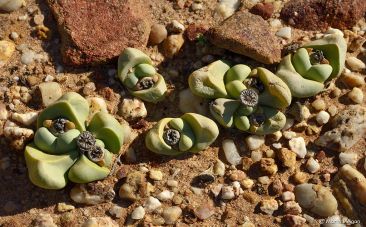Karoo succulents flourish in the newly declared Knersvlakte Nature Reserve
South Africa info reporter
Just three hours north of Cape Town lies a little-known biodiversity hotspot,
where tiny succulents battle the elements amid hectares of white quartzite gravel.
Bababoudjies (Argyroderma), krapogies (Oophytum oviforme) and tuim-en-vinger
(Mesembryanthemum digitata) hunker down under the gravel pebbles, their thick
leaves belying their delicate natures as endemic plants that scrape a precarious
existence from the harsh arid surrounds of the Knersvlakte.
Now these scrappy succulents have an ally in the National Environmental
Management: Protected Areas Act as it protects the 85 500 hectare area a nature
reserve. The Knersvlakte Nature Reserve is the first to be declared for 20 years in the
Western Cape and falls within the Succulent Karoo region; it is located north of the
Olifants River from Klawer to just south of Kliprand in the Western Cape and Northern
Cape respectively. It is three times the size of the Table Mountain National Park.
WWF South
Africa, CapeNature and the Leslie Hill Succulent Karoo Trust
announced the declaration at the historical Griqua farm Ratelgat near Vanrhynsdorp
on Wednesday, 24 September.
Speaking at the event, Dr Morné du Plessis, CEO at WWF South Africa, said, “We
are celebrating an extremely vital moment in our country’s conservation history by
protecting this seemingly desolate, largely under-appreciated area. This land holds
immense biodiversity, and its plants have adapted to the arid hot climate making
them beautifully unique.”
A biodiversity research hotspot
Gail Cleaver-Christie, CapeNature’s executive director of conservation
management said, “This is a truly wonderful achievement for conservation in South
Africa. The diversity and high numbers of endemic plant species [in the reserve]
makes the Knersvlakte a region of international importance with research being done
by both local and international botanists.”
The Succulent Karoo
contains about one third of the world’s approximately 10
000 succulent species.
Seemingly barren, the reserve homes some 1 500 plant species, with 190
endemic species, of which 155 are threatened with extinction according to the IUCN’s
Red list of species in the area. The plants, although uniquely adapted to the area’s
weather and conditions, are also vulnerable to climate change.
Cleaver-Christie said “In the last five years, the number of endemic plant species
has increased from 138 to 186, which is an indicator of active research and interest in
the Knersvlakte. New species are still being discovered.”
Natasha Wilson, programme manager at WWF-SA’s Land Programme, “Much like
the wider West Coast area being a drawcard for the blankets of brightly coloured
wildflowers in September, the beauty of the Knersvlakte is that these delicate plants
are on display all year round. They’re offset exquisitely against the crisp white quartz
as if they
have just popped up through a scattering of snow.”
The Knersvlakte is known for its characteristic white quartzite.
The reserve area is owned by WWF-SA through the funding of the LHSKT and is
managed by CapeNature with an advisory board comprising the South African
National Biodiversity Institute, CapeNature and local landowners and will grow
protected areas in South Africa in accordance with the Protected Areas Act.
Related links:
WWF-SA
CapeNature
South African National Biodiversity
Institute
 Bababoudjies flower in the succulent Karoo’s arid soil, revealing a flora wonderland to the determined botanist. (Photo: Martin Heigan)
Bababoudjies flower in the succulent Karoo’s arid soil, revealing a flora wonderland to the determined botanist. (Photo: Martin Heigan)


